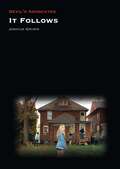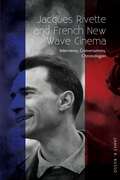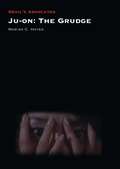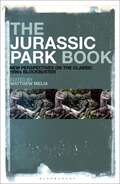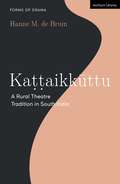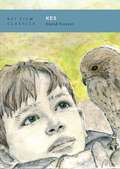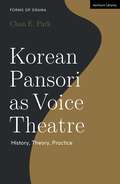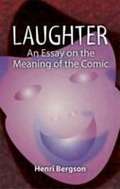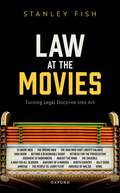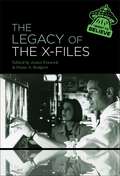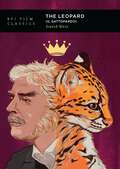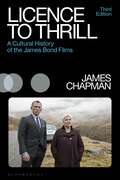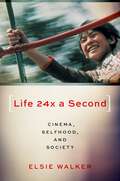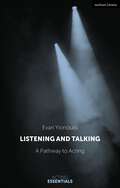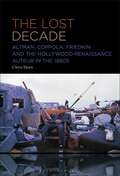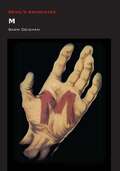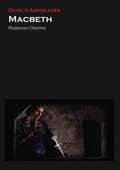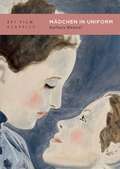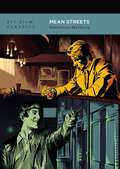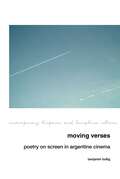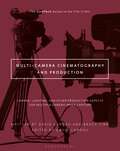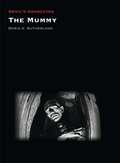- Table View
- List View
It Follows (Devil's Advocates)
by Josh GrimmAmid a recent resurgence in horror films, David Robert Mitchell’s It Follows stands out as a particularly bold entry, a horror fan’s dream come true that sparked a renewed creativity. Pulling a robust 97% on Rotten Tomatoes, It Follows was hailed as a “teen movie you’ve never seen before,” a “creepy, mesmerizing exercise in minimalist horror,” “the best horror film in years,” and simply, “so damn good.” Mitchell uses a variety of approaches to reinvent genre bromides while simultaneously embracing and challenging tropes that audiences and filmmakers rely on a little too heavily. It Follows is one of the best because it is one of the most unique. In this Devil’s Advocate, Joshua Grimm focuses on how this film helped reinvent the rules of a horror movie, particularly along the lines of genre, style, sex, and gender.
Jacques Rivette and French New Wave Cinema: Interviews, Conversations, Chronologies
by James R RussoThis first comprehensive English collection of the interviews of Jacques Rivette (19282016) documents his career through chronology, filmography, bibliography, and image stills. A comprehensive introduction places this work in the wider context of twentieth-century social change. Rivettes films, like many of the works of the French New Wave, seem to have avoided the aging process entirely, remaining as playful, fresh, and quietly spectacular as the day they were made. Indeed, his body of work may be the most impressive of the French New Wave. Celine and Julie Go Boating (1974) has been recognized as possibly the best film to emerge from the post-New Wave era, even as Paris Belongs to Us (1961) is one of the best pictures to emerge from the New Wave itself. Rivette was hardly the most prolific director, however, and the length of his films has often counted against him. Nonetheless, his clinical, self-reflexive essays in film form reveal him as a cinematic purist whose commitment to the celluloid muse hardly diminished from the heady days of the early 1950s to the end of his career in 2009. Beyond inspiring the New Wave movement and continuing to reflect, and reflect on, its central tenets, Rivettes enduring contribution to the history of film is unquestionably evident in his sensitive treatment of the histories and destinies of women, especially through strong roles for actresses. During the six decades of his career, nonetheless, he struck a subtle balance not only between female and male characters, but also between political and personal obsession, between myth and fiction, between theater and cinema, in films that, in addition to having influenced such contemporary filmmakers as Claire Denis, Jim Jarmusch, Olivier Assayas, and David Lynch, continue to redefine the art of cinema around the world.
Ju-On: The Grudge (Devil's Advocates)
by Marisa HayesTakashi Shimizu's Ju-on franchise was a principal instigator in the rise of contemporary Japanese horror and its international popularity at the turn of the millennium. Following the success of Hideo Nakata's Ringu (1998), the first cinematic release of Ju-on: The Grudge in 2002 crystallized Japanese horror's rise to prominence and outlined the new decade's thematic interest in supernatural technology and fear of contagions, while skillfully navigating domestic social concerns, such as Japan's growing elderly population and domestic violence.This Devil's Advocate explores the production roots of Ju-on The Grudge, followed by a critical reading of the film that highlights its essential themes and motifs, in addition to a section on cultural influences, before concluding with a section on Shimizu's continued involvement with the Ju-on franchise and its ongoing legacy. The book serves as an excellent primer for readers without prior knowledge of Japanese horror or the Ju-on film cycle, while providing fresh perspectives on the film that makes it equally appealing to J-horror aficionados.
The Jurassic Park Book: New Perspectives on the Classic 1990s Blockbuster
The definitive 1990s blockbuster, Steven Spielberg's Jurassic Park met with almost universal critical and popular acclaim, broke new ground with its CGI recreation of dinosaurs, and started one of the most profitable of all movie franchises. To mark the film's 30th anniversary, this exciting illustrated collection of new essays interrogates the Jurassic Park phenomenon from a diverse range of critical, historical, and theoretical angles. The primary focus is on Jurassic Park itself but there is also discussion of the franchise and its numerous spin-offs.As well as leading international scholars of film studies and history, contributors include experts in special effects, science on screen, fan studies, and palaeontology. Comprehensive, up to date, and accessible, The Jurassic Park Book appeals not only to students and scholars of Hollywood and contemporary culture, but also to the global audience of fans of the greatest of all dinosaur movies.
Kattaikkuttu: A Rural Theatre Tradition in South India (Forms of Drama)
by Hanne M. BruinThis is the first book to offer a clear introduction to Kattaikkuttu (or Terukkuttu), a vibrant, vocal and physical outdoor Tamil theatre tradition from India. It describes the theatre's characteristic heroic nature as expressed through its principal, male kattai characters, explores its history, social status and ritual context, and examines the production of all-night plays. After placing Kattaikkuttu in the wider, competitive context of the performing arts in India, Hanne M. de Bruin introduces readers to some of the debates about the form and provides an overview of the different elements that make up a Kattaikkuttu performance. It considers its performance spaces and the way the form has changed, such as its transition towards an independent and more professional theatre genre, as well as the opening up of the form to different castes and to women. It covers the production and frameworks of all-night performances, uses the Mahabharata play Karna Moksam as a case study and examines recent changes in the Kattaikkuttu repertory. In addition, the book looks in more detail at the role of the performer, including the training of a Kattaikkuttu novice, the performance score of actor-singers that underlie a specific role or vesam, and a seasoned performer's agency in interpreting well-known roles. Finally, the study turns to recent innovations, in particular the creation of new work and the Kattaikkuttu Gurukulam.
Kes (BFI Film Classics)
by David ForrestKen Loach's 1969 drama Kes, considered one of the finest examples of British social realism, tells the story of Billy, a working class boy who finds escape and meaning when he takes a fledgling kestrel from its nest.David Forrest's study of the film examines the genesis of the original novel, Barry Hines' A Kestrel for a Knave (1968), the eventual collaboration that brought it to the screen, and the film's funding and production processes. He provides an in depth analysis of key scenes and draws on archival sources to shed new light on the film's most celebrated moments. He goes on to consider the film's lasting legacy, having influenced films like Ratcatcher (1999) and This is England (2006), both in terms of its contribution to film history and as a document of political and cultural value. He makes a case for the film's renewed relevance in our present era of systemic economic (and regional) inequality, alienated labour, increasingly narrow educational systems, toxic masculinity, and ecological crisis. Kes endures, he argues, because it points towards the possibility for emancipation and fulfilment through a more responsive and nurturing approach to education, a more delicate and symbiotic relationship with landscape and the non-human, and an emotional articulacy and sensitivity shorn of the rigid expectations of gender.
Korean Pansori as Voice Theatre: History, Theory, Practice (Forms of Drama)
by Chan E. ParkThis book introduces readers to the historical, performative, and cultural context of pansori, a traditional Korean oral story-singing art. Written by a scholar-practitioner of the form, this study is structured in three parts and begins by introducing readers to the technical, aesthetic, and theoretical components of pansori, as well as the synthesis of vocal and percussive elements that stage the narrative. It moves on to reflect on the historical contexts of pansori, alongside Korea's transformation from Joseon monarchy to modern statehood. It argues that with colonial annexation came modernist influences that Korean dramatists and audiences used to create new genres of performance, using the common thread of pansori. The book's third part explores the interplay of preservation and innovation, beginning in the post-war period and continuing with developments in the 20th and 21st centuries that coincide with Korea's imprint on cultural globalization. Along with Korea's growth as a world economic center, a growing enthusiasm for Korean culture around the world has increased the transmission and visibility of pansori. This study argues that tradition and innovation are not as divergent as they are sometimes imagined to be and that tradition is the force that enables innovation. Drawing on Chan E. Park's ethnographic work and performance practice, this book interweaves expert knowledge of both the textual and performative aspects of pansori, rendering legible this dramatic tradition.
Kubrick and Control: Authority, Order and Independence in the Films and Working Life of Stanley Kubrick (Stanley Kubrick Studies)
by Jeremy CarrKubrick and Control is an examination of authority, order, and independence in the films directed by Stanley Kubrick, as well as in his personal life and working habits. This study explores the ways in which these central preoccupations develop and reformulate through the course of Kubrick's career, as he moved from genre to genre and shifted stories, locations, time periods, scope, and technical facilities. Separating the productions in accordance to their wider filmic classifications, the individual chapters examine a variety of productions, allowing for a categorical as well as a developmental approach to the works. In addition, following concurrently with each individual film discussed, details about Kubrick's life and evolving directorial practice are recounted in relation to these same concerns. In studying the stylistic and narrative features of his work, examples illustrate how Kubrick took these themes and applied them consistently yet with significant variation, manifest in relation to mise-en-scène construction (how Kubrick composed his images); characterization (individuals establishing, exerting, seeking, and/or abusing their authority); narrative (stories about characters and situations dependent upon order and control); and the actual filmmaking processes of the director (Kubrick was both praised and damned for his authorial management and obsession with order and perfection).
Laughter: An Essay on the Meaning of the Comic
by Henri BergsonIn this great philosophical essay, Henri Bergson explores why people laugh and what laughter means. Written at the turn of the twentieth century, Laughter explores what it is in language that makes a joke funny and what it is in us that makes us laugh. One of the functions of humor, according to Bergson, is to help us retain our humanity during an age of mechanization. Like other philosophers, novelists, poets, and humorists of his era, Bergson was concerned with the duality of man and machine. His belief in life as a vital impulse, indefinable by reason alone, informs his perception of comedy as the relief we experience upon distancing ourselves from the mechanistic and materialistic. "A situation is always comic," Bergson notes, "if it participates simultaneously in two series of events which are absolutely independent of each other, and if it can be interpreted in two quite different meanings. " The philosopher's thought-provoking insights (e. g. , "It seems that laughter needs an echo. Our laughter is always the laughter of a group. ") keep this work ever-relevant as a thesis on the principles of humor.
Law at the Movies: Making Change in the Networked Public Sphere (Law and Literature)
by Thomas J BillardTransgender rights have emerged as an important topic of everyday conversation across the country in recent years and become, in many ways, the flashpoint du jour of the American culture wars. During the Trump presidency in particular, transgender people were thrust onto the center stage of US politics. Faced with unrelenting hostility and an increasingly complicated media system, transgender activists crafted new communication strategies to fight for their equality, stall attempts to undermine their rights, and win the support of large swathes of the public. In Voices for Transgender Equality, Thomas J Billard offers an insider's view into transgender activism during the first two years of the Trump administration. Drawing on extensive on-the-ground observation at the National Center for Transgender Equality, Billard shows how these activists developed an unlikely blend of online and offline strategies to saturate a diverse ecology of national news outlets, local and community media outlets across the country, and both public and private conversations across multiple social media platforms with voices in support of their cause. Moreover, these activists navigated the complex flows of information and ideas among these different domains of the communication system as they worked to shape the national conversation on transgender rights. As Billard argues, this movement occurred at a very particular time in the development of the media system, with "new" media shaping the movement in important ways that are both generalizable to other social movements and unique to transgender activism. Including rich storytelling and insightful analysis, Voices for Transgender Equality makes a compelling case of what it takes to make social and political change in a world transformed by digital media. Along the way, Billard provides key insights into the new business-as-usual of mediated politics and valuable lessons for more effective activism.
Law at the Movies: Turning Legal Doctrine into Art (Law and Literature)
by Prof Stanley FishThis book asks "How can legal doctrine be turned into filmic art?" By "legal doctrine" Stanley Fish does not mean the sonorous abstractions that usually accompany the self-presentation of law--Justice, Equity, Equality, Liberty, Autonomy, and the like. Rather he has in mind the specific rules and procedures invoked and analyzed by courts on the way to declaring a decision--lawyer/client confidentiality, the distinction between interdicted violence and the violence performed by the legal system, the interplay of positive law and laws rooted in morality, the difference between civilian law and military law, the death penalty, the admissibility of different forms of evidence. In the movies he discusses, these and other points of doctrine and procedure do not serve as a background, occasionally visited, to the substantive issues that drive the plot and provide the characters with choices; they declare the plot, and character is formed and tested in relationship to their demands. Apparently technical matters are pressed until they occupy both foreground and background and become the movie's true subject. If large, abstract concepts emerge, they emerge at the back end of doctrine and are, in effect, produced by doctrine. These are not law-themed movies; they are movies about the unfolding of legal process.
The Legacy of The X-Files
The Legacy of The X-Files examines the content and production of the show, its reception, its use of legend and folklore, its contemporary resonance in politics and society of the 21st century, and its impact and legacy on film, television, the Internet and beyond. Having converged with the early widespread use of the Internet, The X-Files became a cultural touchstone of the 1990s, transforming from a cult TV show into a pop cultural phenomenon by the end of the decade. To celebrate the 30th anniversary of The X-Files, this collection examines the content and production of the show, its reception, its use of legend and folklore, its contemporary resonance in politics and society of the 21st century, and its impact and legacy on film, television, the Internet and beyond. The series' themes of government mistrust, conspiracy, folklore, UFOlogy, and faith are dissected and applied to how the show spirituality resonated with post-Cold War Western society.Contributors to this collection discuss the wide-ranging impact of the television show in popular culture, from Mulder and Scully 'shippers' to the show's slogan entering the contemporary lexicon. The Legacy of The X-Files serves as an all-encompassing, multi-disciplinary, contemporary account of The X-Files, reflecting upon critical, historical, political, and social contexts, and featuring an in-depth and comprehensive introduction making it a vital work for researchers and students alike.
The Leopard (BFI Film Classics)
by David WeirLuchino Visconti's The Leopard (Il Gattopardo, 1963) tells the story of an aristocratic Sicilian family adjusting to the realities of political and commercial modernity after the unification Italy during the Risorgimento.The film, starring Claudia Cardinale, Burt Lancaster and Alain Delon, met with success upon its initial release, winning the Palme d'Or at Cannes and having a successful theatrical run in Europe. Despite this, however, it did not do well with English-speaking audiences, and eventually even fell out of favour with Italian audiences, who took issue with the way Risorgimento history was represented. David Weir's study of the film seeks to understand the film's paradoxical place in Italian film history. He argues that Visconti's use of artifice, narrative and history, all aspects that came to be criticised, were in fact, essential to his cinematic art, and can all be understood as strengths of the film. Providing a scene-by-scene analysis of the film, as well as illuminating its relationship to the Lampedusa novel from which it was adapted, Weir suggests that Visconti's film goes beyond mere adaptation, using the form of the novel for cinematic purposes and making The Leopard a cinematic novel in its own right. He goes on to situate the film within Visconti's career, questioning whether the uneven reception of the film reflects the paradox of Visconti's social status as a Marxist aristocrat and his position as an auteur director whose films borrowed heavily from the decadent tradition, while at the same time professing allegiance to the Italian Communist Party.
Licence to Thrill: A Cultural History of the James Bond Films (Cinema and Society)
by Prof James ChapmanIn this new edition of Licence To Thrill, James Chapman builds upon the success of his classic work, regarded as the definitive scholarly study of the history of the James Bond film series from the first picture, Dr No (1962), to the present. He considers the origins of the films in the spy thrillers of Ian Fleming and examines the production histories of the films in the contexts of the British and international film industries.This edition includes a new introduction and chapters on Quantum of Solace (2008), Skyfall (2012), Spectre (2015) and No Time to Die (2021). Chapman explores how the films have changed over time in response to developments in the wider film culture and society at large. He charts the ever-evolving Bond formula, analysing the films' representations of nationhood, class, and gender in a constantly shifting cinematic and ideological landscape.
Life 24x a Second: Cinema, Selfhood, and Society
by Elsie WalkerLife 24x a Second highlights the life-sustaining and life-affirming power of cinema. Author Elsie Walker pays particular attention to pedagogical practice and students' reflections on what the study of cinema has given to their lives. This book provides multiple perspectives on cinema that matters for the deepest personal and social reasons-from films that represent psychological healing in the face of individual losses to films that represent humanitarian hope in the face of global crises. Ultimately, Walker shows how cinema that moves us emotionally can move us toward a better world. Life 24x a Second makes the case for cinema as a life force in uplifting and widely relatable ways. Walker zeroes in on films that offer hope in relation to the Black Lives Matter movement (Imitation of Life, 1959, and BlacKkKlansman, 2018); contemporary feminism (Nobody Knows, 2004); rite-of-passage experiences of mortality and mourning (Ikiru, 1952, and A Star Is Born, 2018), and first-love grief (Call Me by Your Name, 2017, and Portrait of a Lady on Fire, 2019). Life 24x a Second invites readers to reflect on their own unique film-to-person encounters along with connecting them to others who love cinematic lessons for living well.
Listening and Talking: A Pathway to Acting (Acting Essentials)
by Ms Evan YionoulisListening and Talking: A Pathway to Acting provides undergraduate acting students with a clear, achievable, step-by-step way to approach the work of playing a role. The text is supplemented by exclusive video material to take the actor from their first encounter with the text through rehearsals with fellow actors and into performance. Drawing from the author's twenty years' experience of teaching at the Yale School of Drama, this book, which is influenced, too, by the work of legendary teachers such as Konstantin Stanislavski and Uta Hagen, presents a thorough examination of key aspects of the actor's technique (for example, listening, playing an action and pursuing an objective). Throughout, it includes exercises and process points through which students can put into practice the key lessons from each chapter.The practices laid out in this book form a holistic curriculum that not only ensures measurable results over a semester- or year-long course, but also sets in motion an internal process that will serve the student over their life as an artist.
The Lost Decade: Altman, Coppola, Friedkin and the Hollywood Renaissance Auteur in the 1980s
by Dr. Chris HornProvides an analysis of Hollywood from a fresh viewpoint that shows the careers of Robert Altman, Francis Coppola, William Friedkin, and others in the 1980s as far from conforming to a monolithic pattern of decline, but rather as diverse and complex responses to political and industrial changes.The 1980s are routinely seen as the era of the blockbuster and of 'Reaganite entertainment,' whereas the dominant view of late 1960s and early 1970s American film history is that of a 'Hollywood Renaissance', a relatively brief window of artistry based around a select group of directors. Yet key directors associated with the Renaissance period remained active throughout the 1980s and their work has been obscured or dismissed by a narrow, singular model of American film history.This book deals with industrial contexts that conditioned these directors' ability to work creatively, but it is also very much about the analysis of individual films, bringing to light a range of unheralded work, from the visual experimentation of One from the Heart (Coppola, 1981) to the experimental production contexts of Secret Honor (Altman, 1984) and the stylistic élan of To Live and Die in L.A. (Friedkin, 1985). Behind the homogenous picture of the decline of the auteur in 1980s American cinema are films and careers that merit greater attention, and this book offers a new way to perceive individual films, American film history, and the viability of sustained authorial creativity within post-studio era Hollywood.
M (Devil's Advocates)
by Samm DeighanFritz Lang’s first sound feature, M (1931), is one of the earliest serial killer films in cinema history and laid the foundation for future horror movies and thrillers, particularly those with a disturbed killer as protagonist. Peter Lorre’s child killer, Hans Beckert, is presented as monstrous, yet sympathetic, building on themes presented in the earlier German Expressionist horror films like The Cabinet of Dr. Caligari and The Hands of Orlac. Lang eerily foreshadowed the rising fascist horrors in German society, and transforms his cinematic Berlin into a place of urban terror and paranoia. Samm Deighan explores the way Lang uses horror and thriller tropes in M, particularly in terms of how it functions as a bridge between German Expressionism and Hollywood’s growing fixation on sympathetic killers in the ‘40s. The book also examines how Lang made use of developments within in forensic science and the criminal justice system to portray a somewhat realistic serial killer on screen for the first time, at once capturing how society in the ‘30s and ‘40s viewed such individuals and their crimes and shaping how they would be portrayed on screen in the horror films to come.
Macbeth (Devil's Advocates)
by Rebekah OwensWhy write about Roman Polanski's Macbeth (1971) as part of a series of books dedicated to the classics of the horror movie genre? Because, Rebekah Owens argues, just as Banquo in Polanski's film holds up a series of mirrors that reflect images of his successors that trace back to his own son Fleance, so subsequent milestones in the genre show their lineage to this work, their originator. Polanski had previously made Repulsion (1965) and Rosemary's Baby (1968), so he was fully aware of the conventions of the horror genre and this film provides clues to his own horror lexicon. This book demonstrates how Macbeth can be read as part of the British Folk tradition, strengthening the reading of the film as a horror movie in its own right through its links to The Wicker Man (1973), Blood on Satan's Claw (1971) and Witchfinder General (1968) then argues the case for its recognition as a horror movie even further, by connecting it to the later American horror classics, such as Halloween (1978). It also explores the popular associations made between the film and Polanski's own life, arguing that they endorse the view of the film as a horror. This book represents the first serious attempt to regard Polanski's Macbeth as a horror film in its own right, and not exclusively as one of a multitude of ongoing Shakespeare film adaptations.
Mädchen in Uniform (BFI Film Classics)
by Barbara MennelLeontine Sagan's Mädchen in Uniform (1931) is a groundbreaking German film that showcases women's agency and desire behind and in front of the camera.Adapted from Christa Winsloe's lesbian play, the story follows Manuela, an orphan in a boarding school for impoverished Prussian nobility. When she declares her love with her female teacher, the oppressive principal punishes her, leading to a desperate suicide attempt.Barbara Mennel's compelling study firmly establishes Mädchen in the Weimar cinema canon. Mennel contextualises the film in 1920s theories of sexuality and the conventions of modernist cinema. She contrasts its international success to the extensive censorship battles that surrounded it. The film's unique transnational and fragmented history results from the exile of many of its makers during the Nazi regime. By attending to the many remakes throughout the 20th and 21st century, Mennel underscores the film's timeless impact that continues to resonate with contemporary audiences.
The Masque of the Red Death (Devil's Advocates)
by Steve HabermanThe Masque of the Red Death (1964), the seventh collaboration between producer-director Roger Corman and horror icon Vincent Price, became the crowning achievement for both men, their masterpiece. After the critical and commercial success of House of Usher in 1960, Corman fervently desired to adapt Edgar Allan Poe’s story, ‘The Masque of the Red Death’ as his next project, but the tale took three years to finally become, not Corman’s second Poe film, but his second to last. Its long development benefitted the end result, and the story of its making reveals the persistence and vision of Corman, the artist and entrepreneur of classic horror. In this Devil’s Advocate, Steve Haberman takes an auteurist approach to the film with Corman as the ultimate author of the work. He explores the emergence of Corman’s themes and techniques through directorial control and compares them with the intentions and concerns of the story’s original creator, Poe. In his research, Haberman secured both drafts of the script, the first by Charles Beaumont and the last by R. Wright Campbell, consulted published interviews and met with Corman. The result illuminates not only the film but the profound and profoundly dark world views of both Roger Corman and Edgar Allan Poe.
Mean Streets (BFI Film Classics)
by Demetrios MatheouMean Streets was Martin Scorsese's third feature film, and the one that confirmed him as a major new talent. On its premiere at the New York Film Festival in 1973, the critic Pauline Kael hailed the film as 'a true original of our period, a triumph of personal film-making'. The tale of combative friends and small-time crooks is set amid the bars, pool halls, tenements and streets of Manhattan's Little Italy. Scorsese has said of his childhood neighbourhood, 'its very texture was interwoven with organised crime', and this quality would dramatically inform the tone and restless energy of his seminal film.Demetrios Matheou's insightful study considers Mean Streets' production history in the context of the New Hollywood period of American cinema, noting also the key roles played by John Cassavetes and Roger Corman. He analyses the importance of Scorsese's background to the film's characters and themes, including preoccupations with guilt, redemption and criminal subcultures; the development of the director's film-making process and signature style; the way in which he both drew upon and invigorated the crime genre; his relationship with emerging stars Robert De Niro and Harvey Keitel, and the film's reception and legacy. Matheou argues that while Taxi Driver (1976) and Raging Bull (1980) are regarded as Scorsese's greatest films of the period, Mean Streets is the more influential achievement. With it, Scorsese not only paved the way for a new kind of crime movie, not least his own GoodFellas (1990), but also inspired generations of independently-minded film-makers.
Moving Verses: Poetry on Screen in Argentine Cinema (Contemporary Hispanic and Lusophone Cultures #24)
by Ben BolligFrom Wild Tales to Zama, Argentine cinema has produced some of the most visually striking and critically lauded films of the 2000s. Argentina also boasts some of the most exciting contemporary poetry in the Spanish language. What happens when its film and poetry meet on screen? Moving Verses studies the relationship between poetry and cinema in Argentina. Although both the “poetics of cinema” and literary adaptation have become established areas of film scholarship in recent years, the diverse modes of exchange between poetry and cinema have received little critical attention. The book analyses how film and poetry transform each another, and how these two expressive media behave when placed into dialogue. Going beyond theories of adaptation, and engaging critically with concepts around intermediality and interdisciplinarity, Moving Verses offers tools and methods for studying both experimental and mainstream film from Latin America and beyond. The corpus includes some of Argentina’s most exciting and radical contemporary directors (Raúl Perrone, Gustavo Fontán) as well as established modern masters (María Luisa Bemberg, Eliseo Subiela), and seldom studied experimental projects (Narcisa Hirsch, Claudio Caldini). The critical approach draws on recent works on intermediality and “impure” cinema to sketch and assess the many and varied ways in which directors “read” poetry on screen.
Multi-Camera Cinematography and Production: Camera, Lighting, and Other Production Aspects for Multiple Camera Image Capture (The CineTech Guides to the Film Crafts)
by David Landau Bruce FinnA how-to book on the art, craft and practice of TV/video/streaming cinematography for multi-camera shooting.This book is written for anyone wanting to film, direct or produce multiple camera productions. Lighting Directors, Directors of Photography, Camera Operators as well as Directors, Producers and Production Managers will all find valuable information that will help them do their job and accomplish their goals of effectively filming with more than one camera at the same time. This book could be seen as an intermediate to advanced media production course book for colleges. It is also meant to give insight and inspiration to those starting out their professional careers in multi-camera productions. The text covers advice for producing and filming content using two or more cameras in many genres including Sitcom, Stand-up, News, Talk Show, Interview, Reality, Corporate Video and Indie Movies, with budgets both big and small, by two award winning professional industry cinematographers/lighting directors with over 30 years of experience each.
The Mummy (Devil's Advocates)
by Doris SutherlandReleased in 1932, The Mummy moved Universal horror away from the Gothic Europe of Dracula and Frankenstein and into a land of deserts, pyramids, and long-lost tombs. In doing so the film continued a tradition of horror fiction that is almost as old as the Western pursuit of Egyptology, as numerous European and American authors from the nineteenth and early twentieth centuries had portrayed Egypt as a place of mystery and magic. This book examines the roots of The Mummy. It shows how the film shares many of its motifs with the work of writers such as Bram Stoker, Arthur Conan Doyle, and H. Rider Haggard, whose tales of living mummies, immortal sorcerers, and Egyptian mysticism bear strong resemblances to Universal’s movie. In addition, the book discusses how The Mummy drew upon a contemporary vogue for all things ancient Egyptian: the tomb of Tutankhamun was discovered the decade before the film was released, prompting sensationalistic rumors of a curse. This is the story of what happened when Hollywood horror went to Egypt.
